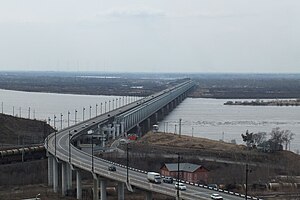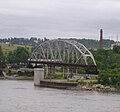Khabarovsk Bridge
Coordinates: 48 ° 32 ′ 10 ″ N , 135 ° 0 ′ 0 ″ E
| Khabarovsk Bridge | ||
|---|---|---|
| Khabarovsk bridge after completion of the second track over the pillars of the old bridge, 2013 | ||
| use | Combined rail and road bridge | |
| Crossing of | Amur | |
| place | Khabarovsk | |
| construction | Steel truss bridge (driveways reinforced concrete girder bridge ) |
|
| overall length | 2599 m (with driveways 3890.5 m) |
|
| width | 25 m | |
| Number of openings | 22 (with driveways 58) | |
| Longest span | 128.4 m | |
| building-costs | 13.5 million rubles (1913-1916) | |
| start of building | August 12, 1913 (reconstruction 1992) |
|
| opening | October 18, 1916 (reconstruction 1998) |
|
| location | ||
|
|
||
| Above sea level | 32 m | |
The Khabarovsk Bridge crosses the Amur River seven kilometers north of downtown Khabarovsk in Russia's Far East . The Russian M 58 “Amur” trunk road runs on the upper floor of the two-story bridge, with the tracks of the Trans-Siberian Railway below it . The bridge, originally built between 1913 and 1916, was reconstructed from 1992 and partially rebuilt. The new bridge, 2599 meters long (with driveways 3890.5 meters), was opened in stages between 1998 and 2009.
Until the opening of the railway bridge at Komsomolsk on the Amur in 1975 along the eastern extension of the Baikal Amur Mainline (BAM) to Sovetskaya Gawan on the Sea of Japan , the Khabarovsk bridge was the only bridge over the almost 3,000 kilometer long river. Further bridges are planned, but have not yet been built. The Khabarovsk Bridge is on the back of the introduced 2006 Russian 5000 rubles - banknote shown the series in 1997.
history
The first investigations into the possibility of building an Amur bridge near Khabarovsk were carried out in 1895 in connection with the construction of the Trans-Siberian Railway. The city was in 1897 by the 1893 coming from Vladivostok guided approach Ussuri Railway reached. However, the main line of the Trans-Siberian Railway was initially run in the form of the Chinese Eastern Railway over the territory of Manchuria and thus the Empire of China , so that the need to build an Amur bridge was initially eliminated.
The defeat of Russia in the Russo-Japanese War 1904/05, which was due not least to the lack of supplies for the troops in the Far East of the country, made the strategic disadvantages of this route clear. In 1906, therefore, the preparatory work for the construction of the Amur Railway began, which, starting from Kuenga (west of Sretensk , where a branch of the Trans-Siberian Railway ended at the Amur source river Schilka since 1900 ) was always to lead on the territory of the Russian Empire to Khabarovsk. For the necessary Amur crossing, a project competition was announced, in the course of which, in addition to bridges, the construction of a tunnel was considered, and which was ultimately won by a group of designers around Lawr Proskuryakov (1858–1926) and Grigory Perederi (1871–1953).
First bridge
The railway line was built in a west-east direction and reached the left bank of the Amur opposite Khabarovsk in 1913. The foundation stone for the bridge construction was on July 30th . / August 12, 1913 greg. placed in the presence of the Governor General of the Amur Region Nikolai Gondatti (1860-1946). The steel components for the bridge girders were manufactured in Warsaw , transported by rail to Odessa , from where they were assembled by sea to Vladivostok and further by rail to Khabarovsk. According to the project, the opening of the bridge was planned for October 1, 1915, but was delayed by the beginning of the First World War . In autumn 1914, the German cruiser Emden sank the Belgian steamship Kortrijk with the parts for the last two bridge girders in the Indian Ocean . New parts had to be ordered in Canada . On October 5th, Jul. / October 18, 1916 greg. traffic over the single-track bridge, which was named after the then twelve-year-old Russian Tsarevich Alexei , finally opened. The cost of construction was 13.5 million rubles.
During the Russian Civil War , on April 5, 1920, two of the bridge girders were blown up by the red troops , who were temporarily withdrawing from Khabarovsk . The railway line was interrupted for five years. Work on restoring the bridge began immediately after the final Soviet takeover of power in the Far East in November 1922; however, traffic could not be resumed until March 22, 1925.
tunnel
In the following decades the single-track bridge remained one of the “bottlenecks” of the Trans-Siberian Railway. After the annexation of Manchuria by Japan in 1931, a strategic decision was made to build an additional single-track tunnel under the Amur as an alternative to the bridge. The work started in 1937 was completed on October 25, 1942 after the first test drive had been carried out on July 12, 1941. Until 1964, the 7,198 meter long tunnel remained an unused military secret object in regular rail traffic. After that, to relieve the bridge, freight trains, later also suburban passenger trains, were directed through the tunnel. Long-distance trains of the Trans-Siberian Railway, which could also be used by foreigners, always drove over the bridge.
In 1979 the railway line was electrified over the bridge and through the tunnel with 25 kV 50 Hz alternating current . The condition of the bridge, especially the girders, deteriorated more and more, so that the maximum speed on the now almost 80-year-old bridge had to be reduced to 15 km / h in the 1990s. In 1990 a reconstruction project was worked out that also included the construction of a road over the bridge.
Reconstruction and second bridge
Work began in 1992 by first erecting new pillars for a new bridge running parallel to the immediately south (upstream) of the existing bridge piers and using their foundations. Rail traffic over the existing bridge was not interrupted during construction. In 1998, rail traffic began over the new bridge, and in 1999 traffic on the road above the railway line. Between 1999 and 2000 the girders of the old bridge were dismantled; one of the old girders was erected as a monument not far from the bridge on the Khabarovsk side.
The implementation of the next construction phase, the construction of a second track over new girders on the repaired pillars of the old bridge, did not begin until 2005 due to financial difficulties. This part of the bridge was put into operation on November 7, 2009. The planned construction of additional lanes of the M 58 trunk road above the second track has not yet been tackled.
literature
- V. Burkova, V. Zuev (eds.): Dal ʹ nevostočnaja magistral ʹ Rossii . Častnaja kollekcija, Khabarovsk 1997, ISBN 5-7875-0002-4 , p. 52–58 ( The Far Eastern Main Line of Russia ; Russian).
Web links
Individual evidence
- ↑ RŽD press release of July 12, 2006 (Russian)
- ↑ G. Afonina: Kratkie svedenija o razvitii otečestvennych železnych dorog s 1838 po 1990 g. MPS, Moscow 1995 ( Brief information on the development of the national railways from 1838 to 1990 ; Russian).
- ↑ Article ( Memento of the original from November 1, 2009 in the Internet Archive ) Info: The archive link was automatically inserted and not yet checked. Please check the original and archive link according to the instructions and then remove this notice. for the commissioning of the first reconstruction section in the information portal of the city of Khabarovsk (Russian, photos)






